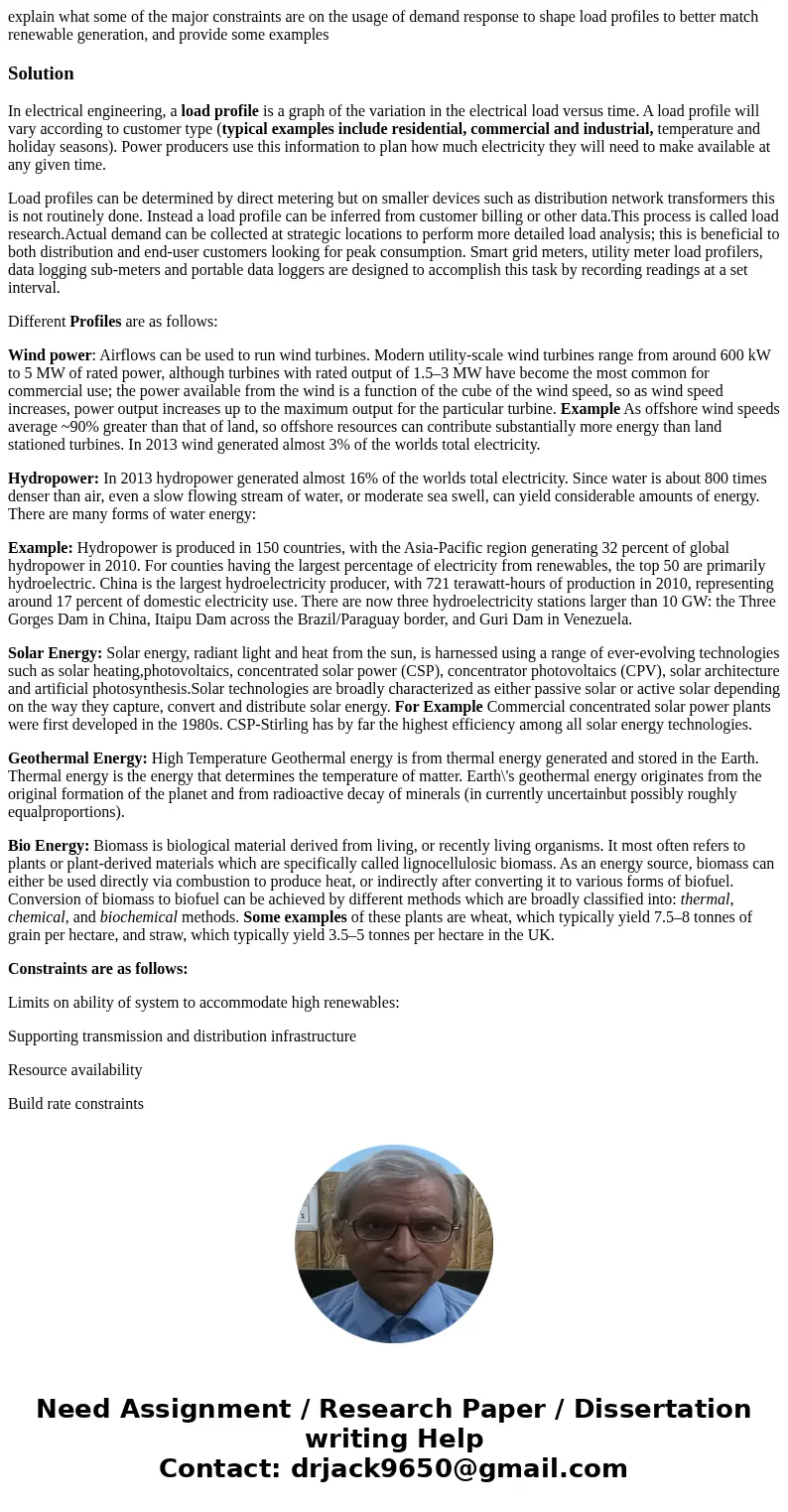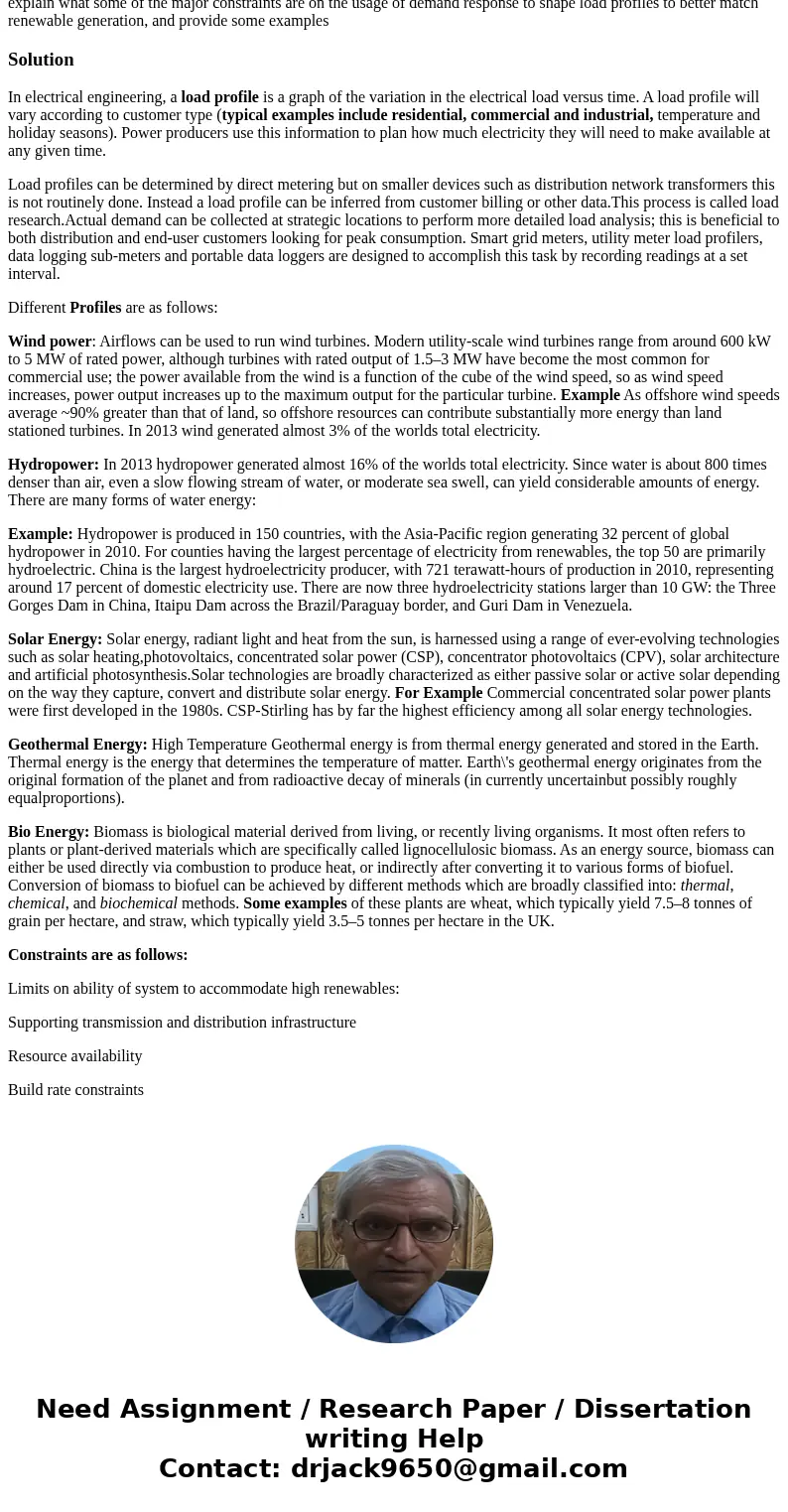explain what some of the major constraints are on the usage
explain what some of the major constraints are on the usage of demand response to shape load profiles to better match renewable generation, and provide some examples
Solution
In electrical engineering, a load profile is a graph of the variation in the electrical load versus time. A load profile will vary according to customer type (typical examples include residential, commercial and industrial, temperature and holiday seasons). Power producers use this information to plan how much electricity they will need to make available at any given time.
Load profiles can be determined by direct metering but on smaller devices such as distribution network transformers this is not routinely done. Instead a load profile can be inferred from customer billing or other data.This process is called load research.Actual demand can be collected at strategic locations to perform more detailed load analysis; this is beneficial to both distribution and end-user customers looking for peak consumption. Smart grid meters, utility meter load profilers, data logging sub-meters and portable data loggers are designed to accomplish this task by recording readings at a set interval.
Different Profiles are as follows:
Wind power: Airflows can be used to run wind turbines. Modern utility-scale wind turbines range from around 600 kW to 5 MW of rated power, although turbines with rated output of 1.5–3 MW have become the most common for commercial use; the power available from the wind is a function of the cube of the wind speed, so as wind speed increases, power output increases up to the maximum output for the particular turbine. Example As offshore wind speeds average ~90% greater than that of land, so offshore resources can contribute substantially more energy than land stationed turbines. In 2013 wind generated almost 3% of the worlds total electricity.
Hydropower: In 2013 hydropower generated almost 16% of the worlds total electricity. Since water is about 800 times denser than air, even a slow flowing stream of water, or moderate sea swell, can yield considerable amounts of energy. There are many forms of water energy:
Example: Hydropower is produced in 150 countries, with the Asia-Pacific region generating 32 percent of global hydropower in 2010. For counties having the largest percentage of electricity from renewables, the top 50 are primarily hydroelectric. China is the largest hydroelectricity producer, with 721 terawatt-hours of production in 2010, representing around 17 percent of domestic electricity use. There are now three hydroelectricity stations larger than 10 GW: the Three Gorges Dam in China, Itaipu Dam across the Brazil/Paraguay border, and Guri Dam in Venezuela.
Solar Energy: Solar energy, radiant light and heat from the sun, is harnessed using a range of ever-evolving technologies such as solar heating,photovoltaics, concentrated solar power (CSP), concentrator photovoltaics (CPV), solar architecture and artificial photosynthesis.Solar technologies are broadly characterized as either passive solar or active solar depending on the way they capture, convert and distribute solar energy. For Example Commercial concentrated solar power plants were first developed in the 1980s. CSP-Stirling has by far the highest efficiency among all solar energy technologies.
Geothermal Energy: High Temperature Geothermal energy is from thermal energy generated and stored in the Earth. Thermal energy is the energy that determines the temperature of matter. Earth\'s geothermal energy originates from the original formation of the planet and from radioactive decay of minerals (in currently uncertainbut possibly roughly equalproportions).
Bio Energy: Biomass is biological material derived from living, or recently living organisms. It most often refers to plants or plant-derived materials which are specifically called lignocellulosic biomass. As an energy source, biomass can either be used directly via combustion to produce heat, or indirectly after converting it to various forms of biofuel. Conversion of biomass to biofuel can be achieved by different methods which are broadly classified into: thermal, chemical, and biochemical methods. Some examples of these plants are wheat, which typically yield 7.5–8 tonnes of grain per hectare, and straw, which typically yield 3.5–5 tonnes per hectare in the UK.
Constraints are as follows:
Limits on ability of system to accommodate high renewables:
Supporting transmission and distribution infrastructure
Resource availability
Build rate constraints


 Homework Sourse
Homework Sourse